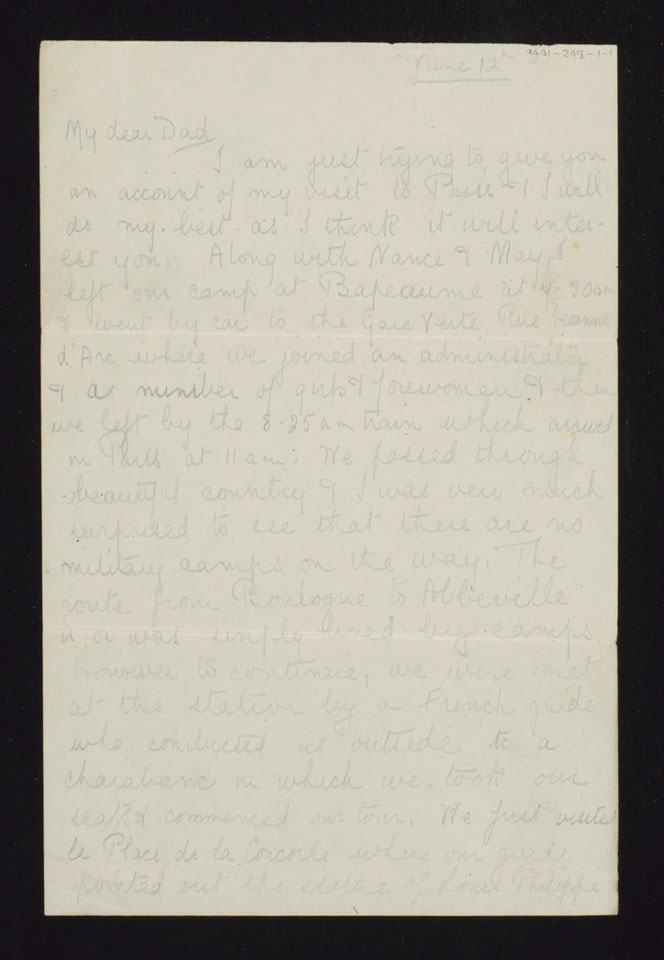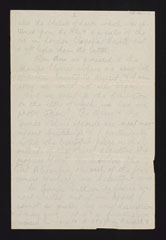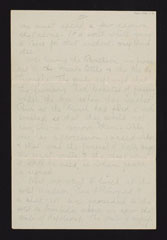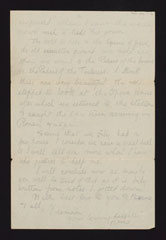
Online Collection
Letter from Lilian Emsley, Queen Mary's Army Auxiliary Corps, to her father from France, 12 June 1918
It reads: 'I am just trying to give you an account of my visit to Paris. I will do my best as I think it will interest you. Along with Nance and May I left our camp at Bapaume at 7.30am. I went by car to the Gare Vente, Rue Jeanne d'Arc where we joined an administrator and a number of girls and forewomen. And then we left by the 8.25 train which arrived in Paris at 11am. We passed through beautiful country and I was very much surprised to see that there are no military camps on the way. The route from Bouolgne to Abbeyville is or was simply lined by camps. However, to continue we were met at the station by a French guide who conducted us outside to a charabanc in which we took our seats and commenced our tour.
We first visited La Place de la Concorde where our guide pointed out the statue of Louis Philippe also the obelisk of Luxor which was obtained from the Nile and is a sister of the one in London, Cleopatra's Needle, but is 7ft higher than the latter. From there we proceeded to the Champs Elysees where we saw lots of people beautifully dressed. I am sorry we could not stay longer. Next we went to the Exhibition on the steps of which we had our photos taken. The Musee and the Grand Palais are most magnificent buildings, and I particularly noted the beautiful frieze on the/ outside of the Musee depicting the progress of Art. We discover the Pont Alexandra on each of the four corners are which are beautiful figures.
The Grand Pantheon de Guerre was next visited but I am afraid I cannot do justice by any description I may give. It was commenced in 1914 and is 350 ft in breadth and 70 ft high. It is hung away from the wall and weighted. I am just puzzled now how to tell you as it is unlike anything I have ever seen before. It seems to be hung in a circular room and one can walk round to view the different sections. It depicts the heroes of the Allies, each in their own group and the background is composed of the battlefields. Everything was so life like, especially one section showing a monument to the dead, on the steps of which, was a kneeling figure in black. A wreath lies near bearing the words, but in French To our unknown heroes. It is impossible for me to tell you more now but as I have got views of it I will explain it more fully when I come home. Dad, you must see it and I should like Mamma to do so, only to fully appreciate it. One must spend a few days on that alone. It is worthwhile going to Paris for that without anything else.
After leaving the Pantheon, we proceeded to the Arcade Etoile and the Arc de Triomphe. The guide explained that the Germans had boasted of passing under the Arc when they reached Paris and so the French had filled it with sandbags so that they would not have time to remove them. Only once has a procession passed under and that was the funeral of Victor Hugo, the great writer, and the next time it will be used is when peace is signed. Next we went to lunch at the Hotel Windsor, Rue de Petrograd and a short rest. We proceeded to the Hotel de Invalides where we saw the tomb of Napoleon. The tomb is magnificent being of granite and marble. There we saw the Royal Chapel dedicated to St Louis, the walls being made of the guns used in the wars of Napoleon I. The altar is splendid, being a copy of St. Peter's in Rome. The stained windows in the chapel give the appearance, even on the dullest day of the light always changing on the tomb, the latter being arranged that that people must bow their heads to look.
We then proceeded to the portion called the Island on which Paris was first built and to the Palais Justice 1163, near the Latin Quarter to the Notre Dame. We went inside the Notre Dame and were fortunate in being whilst a service was taking place. Being Whit Sunday it was a special day, the Archbishop of Paris being there and I was very much surprised when I saw the waiting crowd reach to kiss his gown.
The Hotel de Ville and the Square of Grave, the old execution ground we next saw, then we went to the Palais of the Louvre and the Palais of the Tuilleries. I think these are very beautiful. We next stopped to look at the Opera House after which we returned to the station I caught the 5 pm train arriving in Rouen 7.45 pm. Seeing that we only had a few hours I consider we saw a great deal and I will tell you more when I have the pictures to help me.
I will conclude now as maybe you will be tired of this as it is only written from notes I jotted down. With best love to you and Mama and all I remain your loving daughter Maud'.
From a collection of papers of Miss Maud Lilian Emsley, Women's Army Auxiliary Corps and Queen Mary's Army Auxiliary Corps, 1917-1932.
NAM Accession Number
NAM. 1994-01-248-1
Copyright/Ownership
National Army Museum, London
Location
National Army Museum, Study Collection
Object URL
https://collection.nam.ac.uk/detail.php?acc=1994-01-248-1






